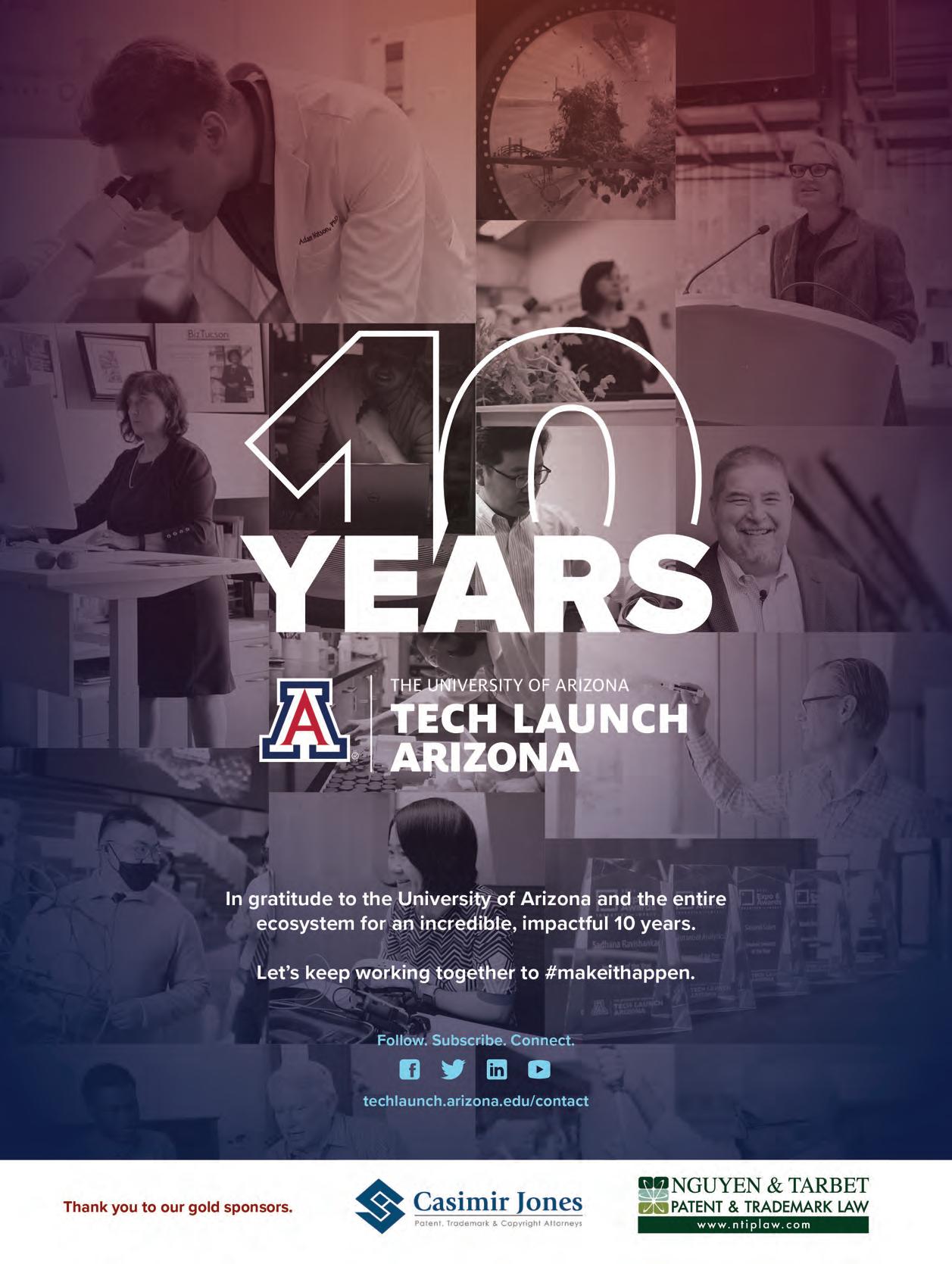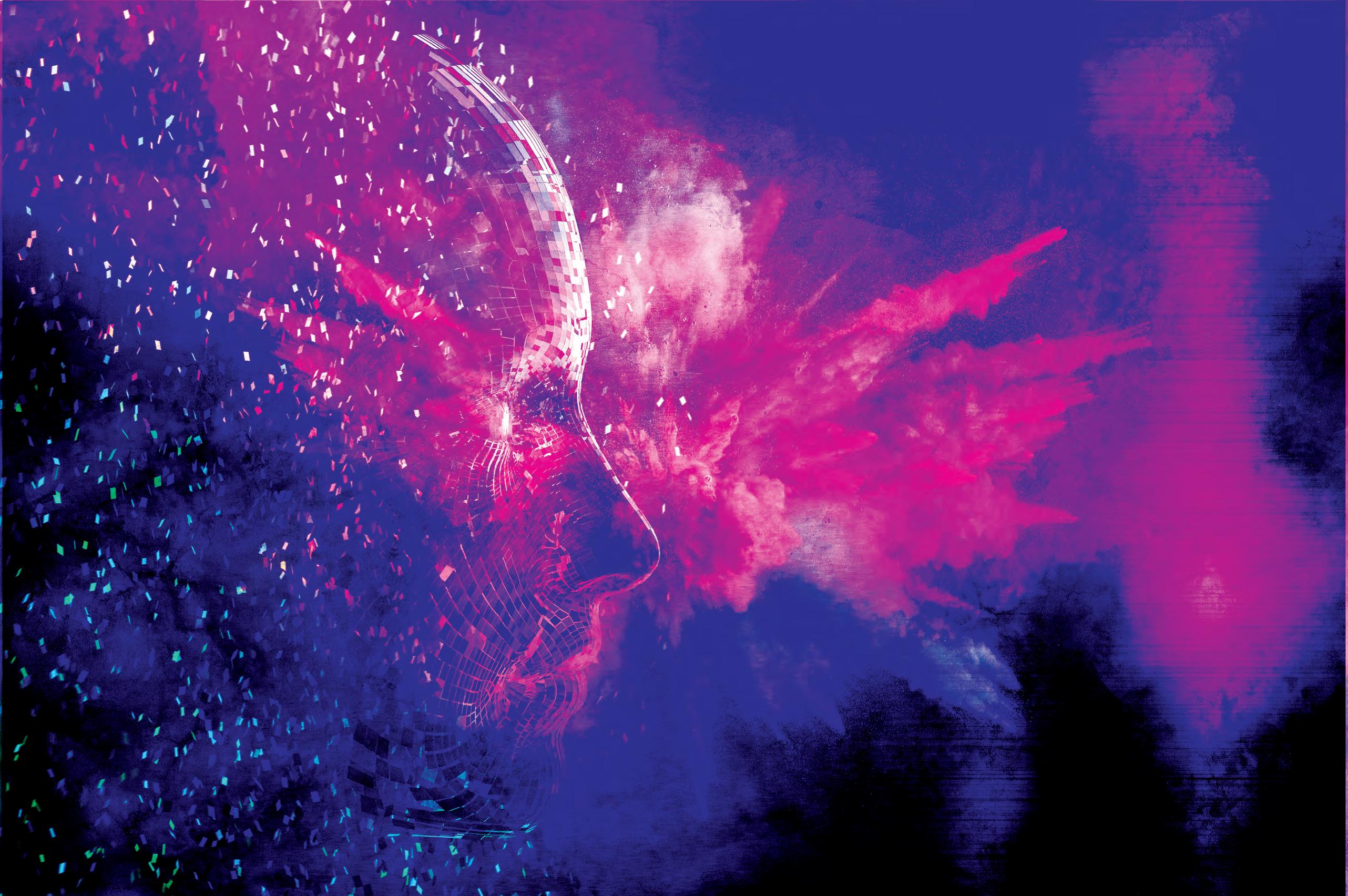



SPECIAL REPORT 2022 THE REGION’S BUSINESS MAGAZINE TECH LAUNCH ARIZONA COMMERCIALIZING UNIVERSITY OF ARIZONA INVENTIONS $1.6 BILLION IN ECONOMIC IMPACT




2013 2015

David Allen hired to build and grow TLA.Public-private partnership to build a Tucson Commercialization Network launched be tween TLA, the City of Tucson and Aztera.
First awards event held to recognize UArizona inventors, startups and ecosystem champions.
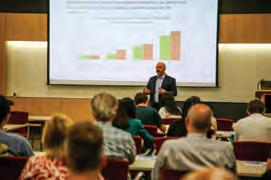
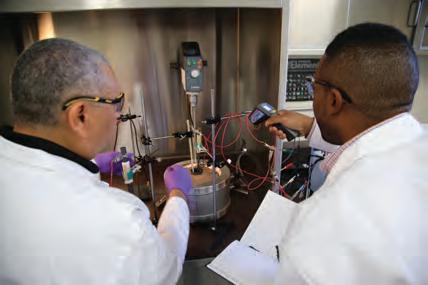

SinofoníaRx launched to commercialize medication management system.

Doug Hockstad joins TLA to lead licensing and intellectual property team.
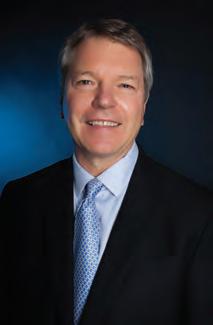
TLA negotiates deal with Alcon to license trifocal lens.

TIMELINE

“We make a concerted effort to make people feel comfortable – to help them understand our support and provide insight into intellectual property and the opportunities for impact available through commercialization.”
– Douglas Hockstad, Associate VP, Tech Launch Arizona
BizINNOVATION 70 BizTucson < < < Fall 2022 www.BizTucson.com
Tech Launch Arizona Marks a Decade
From UArizona Minds to Marketplace
By Jay Gonzales
In the not-so-distant past, ground-breaking research conducted on the Univer sity of Arizona campus more often than not was destined for one place – academic journals.
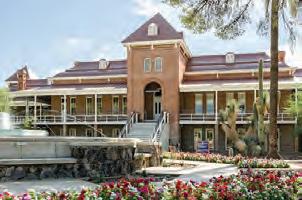

But since 2012, Tech Launch Arizona has pushed open the door to move life-changing technology and inventions

on a path to the consumer market. It’s a turnaround in attitude and operation at UAri zona which has resulted in benefits for multiple constitu ents – for consumers, for the university, for the researchers who devote their lives to their work, and for society.
“When TLA started, it was because university adminis
tration made a conscious de cision to become as good at commercialization as it was at research,” said Associate VP Douglas Hockstad, who has led Tech Launch Arizona since 2018 when he was promoted to replace David Allen, the organization’s first vice president, who answered


2016
UArizona designated National Science Foundation Innovation Corps site.



Commercialization Network project com pletes, and TLA hires Eric Smith as Network Manager
President Robbins arrives at the UArizona UAVenture Capital launched to fund hightech startups affiliated with UArizona.
TIMELINE
Fall 2022 > > > BizTucson 71www.BizTucson.com
continued from page 71
university. “We were a top-tier research uni versity, but we weren’t great at getting it out” into the market.
Fast forward to fiscal year 2021. During that year, TLA executed 124 licenses related to in ventions originating from university research, had 100 patents issued, and started 17 new companies. Since TLA began operating, 128 companies have been formed to commercial ize UArizona inventions.





BizINNOVATION Technology Commercialization – Fiscal Year 2022 Startups Launched 10 Royalties & Other Income $10.4 million Licenses & Options 116 Patents Filed 389 Patents Issued 87 Invention Disclosures 303 FY2021 Research Expenditures $770 million 72 BizTucson < < < Fall 2022 Source: Tech Launch Arizona
arm. “The sum of it is the faculty and the community were ready, and the new administration came in and said, ‘Here are the keys to the car. You go drive.’
“We laid down the roadmap of where we were going and we just gradually turned around the ship. But it doesn’t turn around quickly.”
Hockstad said faculty at the time were not focused on or trained to think that their work might have monetary value or a potentially huge impact on society.

“It’s true everywhere that as faculty are being trained, as they’re getting their Ph.D.s and they’re doing their ear ly research, they learn to focus on pub lication rather than translation,” Hocks tad said. “What’s drilled into them is to publish to become recognized.”



Beacon of success
Allen and Hockstad engaged local businessman Fletcher McCusker and his lifetime business partner Michael Deitch in the establishment of TLA, and they “scoured” the university for a technology that could become a beacon for what they hoped to achieve. Mc Cusker and Deitch were fresh from the sale of a billion-dollar company they had taken public.
“There was a small group of us who really believed,” McCusker said. “Doug Hockstad was a believer. He saw it hap pen at Michigan. (UArizona President) Bobby Robbins was a believer. He saw it happen at Stanford. Betsy Cantwell was a believer. She knew that you could meet the goals of both research and commer cial activity. That small group of tena cious people just wouldn’t let go of the dog bone, and I think faculty members were won over and they saw the oppor
tunities they created for them.”
The search for a marketable technol ogy uncovered medical software de veloped at the R. Ken Coit College of Pharmacy designed to help insurance payers and physicians track and moni tor prescriptions to mitigate dangerous drug interactions. The technology de veloped by UArizona researcher Kevin Boesen attracted $4 million in invest ment and a company was formed. That company, SinfoníaRx, was sold in 2017 for $130 million.

“I think people were skeptical until they saw our first couple of exits,” Mc Cusker said. “We’ve truly made a dozen or more faculty into millionaires be cause they’ve been able to advance their company.”
Over time, Hockstad said, campus re searchers have come to understand the possibilities of their work. They don’t always have an eye toward commer cialization or a goal of getting rich, he said. But as they see the success stories of fellow faculty members, they become more aware of what TLA can do for them and their inventions.
“I don’t know if there ever was a line in the sand that we crossed” to demon strate what Tech Launch Arizona can do, Hockstad said. “The difference is that when we started, more or less ev eryone that we talked to felt that we had a lot to prove. Now, I would say, the majority feeling on campus isn’t that we have a lot to prove, it’s about how we can help them and work them through the process.”
A marketing team headed by Paul Tumarkin has been instrumental in con veying the message that TLA is there to help.
“We’re making sure that we’re telling the right story internally at the univer sity, that we’re reaching out to faculty and helping them understand what we do and how we can help them,” said Tumarkin, assistant director for market ing and communications. “We survey our inventors every year and the vast majority are happy with the service we provide and would recommend work ing with us to their colleagues. The next phase for us is to ensure that we con tinue to grow the numbers of university innovators engaged in the process and keep evolving our innovation culture.”
One-stop shop
Together, Allen and Hockstad built a one-stop shop for faculty members doing research and any UA staffers engaged in innovation that might have a commercial market. One of the key moves was embedding TLA licensing managers in the colleges where intellec tual property – or IP – is produced, such as the colleges of Engineering, Optical Sciences, Medicine, Science, and Life Sciences and Agriculture, said Rakhi Gibbons, director of licensing for TLA.
These specialized team members are physically located in the colleges’ offices and are close advisers to the faculty. They also keep an eye out for work that might have legs in the market.
“The licensing managers, because they’re embedded, usually have a pretty good idea what the faculty and the col lege are working on,” Gibbons said. “They’re there, walking the halls with them. So, we start with a conversation. We sit down with the researcher and we talk about what they’re working on. And then our job is to think about that re
on page
TIMELINE
2022
TLA
2020 2021 TLA signs its 100th startup, GenetiRate 2, LLC Alcon secures approval for trifocal lens in Europe and U.S. for patient use. UArizona rises to #28 among top 100 worldwide universities granted utility patents.
celebrates its 10th anniversary. continued
74 >>> Fall 2022 > > > BizTucson 73www.BizTucson.com
continued from page 73
search and find an application for it that could benefit the public in some way.”


There are many ways that inventions get to market with the help of TLA. After first performing some due dili gence on the invention, the technology can be protected with a patent, copyright or trademark. The rights to the technology can then be licensed to a company – either a startup or an existing company – that will carry on con tinued development and, eventually, produce a product. If a startup is the best path, the inventor will typically take a role in that company, possibly as a leader or as a technology adviser while a more experienced executive


BizINNOVATION 10 Years at Tech Launch Arizona Invention Disclosures 2,455 Exclusive Licenses & Options 492 Total Startups 128 Total U.S. Patents Issued 535 Royalties & Other Income $46.9 million Source: Tech Launch Arizona


 PHOTO: BRENT G. MATHIS
Doug Hockstad
Associate VP
Tech Launch Arizona
PHOTO: BRENT G. MATHIS
Doug Hockstad
Associate VP
Tech Launch Arizona
76 BizTucson < < < Fall 2022 www.BizTucson.com BizINNOVATION
From Computer Engineer to Commercialization
Doug Hockstad Leads Tech Launch Arizona to Prosperity
 By Jay Gonzales
By Jay Gonzales
There was a point in his professional career when Doug Hockstad, like so many others, was at a crossroads – one path continuing toward his life’s work and the other in a direction still rela tively unknown.
A computer engineer, he had worked in the software industry. He had worked in established companies and a startup. He even had worked overseas.
After what Hockstad called the “dot bomb” of the early 2000s, he left the startup and got his first taste of tech nology transfer. Thanks to his software experience, he was hired to help launch a software licensing program at the Uni versity of Michigan that would help in commercializing inventions from the university.
Then came the crossroads.
“I always assumed it would be a tem porary role. I would do it for a while, then I would eventually go back to in dustry and do what I had been doing,” Hockstad said. “After a couple of years, I had an opportunity to go back to in dustry.
“I realized I had to make a decision whether I was going to continue my ca reer as I had envisioned it all my life or was I going to stay doing this. After a little soul searching I just realized that the decision would set the direction for the rest of my life. I really enjoyed what I was doing and the people I was work ing with, and I chose to stay on and keep doing that.”
A dozen years later, Hockstad found himself at the University of Arizona in a similar role, but in an organization in
its infancy.
“I had been watching Arizona − kind of out of the corner of my eye − for a couple of years,” Hockstad said. “It never made sense to me that Arizona, as a top-tier research institution, was not showing up on the commercialization results that I would expect for that level of institution.”
Tech Launch Arizona was formed under the administration of then-Pres ident Ann Weaver Hart. David Allen was hired to lead the new unit and get the office off the ground to start bring ing UArizona research and technology into the market.
“I reached out (to Allen) and said, ‘I want to understand what you’re doing.’ He reached back out to me and said, ‘you need to apply for this role.’ So I did and that was that. I saw it as an oppor tunity to be a part of something brand new, something that was going to really change, not just the university, but the region.”
It was the beginning of a team that has since made a huge economic impact on the university, the researchers and in ventors on campus, students diving into the tech transfer field, and the overall regional economy.
“Doug’s a remarkable leader,” said Betsy Cantwell, senior VP for research and innovation at UArizona. She heads the Office for Research, Innovation and Impact where TLA reports.
“We got Doug from Michigan, which is a place where they really look at this holistic package and value proposition,” Cantwell said. “Doug and his team try
really hard to measure the investors’ portfolios in the companies we spin out as startups. They work directly with Tech Parks (Arizona) on physical loca tions, making sure we have places in Tucson and in Southern Arizona for our startups. They’re very focused on impact measures that don’t just serve the university.”
“Doug has been an excellent team leader and team builder internally,” said Paul Tumarkin, TLA’s assistant director for marketing and communications. “I think he understands every job in the of fice very well and is a great facilitator in that way. He also is very innovative, and he’s outward-looking and forward-look ing at the possibilities and seeing where we can go next.”
Though TLA was essentially new when Hockstad arrived, he knew that his decision to stay in technology trans fer and to do it at UArizona was the right move. In 2018, Allen retired and Hockstad moved into the leadership role.
In 10 years, TLA has started more than 125 companies, had an economic output in the billions, and has given re searchers and inventors on campus an outlet for their life’s work that barely existed at UArizona prior to TLA’s for mation.
“There was never a time where I thought we can’t do this,” Hockstad said. “There was never a time where I thought this is a bigger bite than I ex pected. We knew what we were getting into, but we also knew what steps we had to take to make it happen.”
Fall 2022 > > > BizTucson 77www.BizTucson.com
Biz
The following are companies that Tech Launch Ari zona helped to commercialize inventions created by UArizona faculty and staff. Some already existed and others were startups launched specifically to commercialize UArizona inventions. All have acquired licenses for technologies that they are taking forward.
Alcon
Category: Optics

Year Licensed: 2019 David J. Endicott, CEO Inventor: Jim Schwiegerling
Schwiegerling developed an implantable replacement lens for the eye that allows for mid-range as well as near and far vision and may eliminate the need for glasses or contacts for some. Alcon incorporated the technology into its novel trifocal intraocular lens, PanOptix. Alcon’s PanOptix lenses have now been implanted in over 1 million
Avery Therapeutics
Category: Health/Medical Year Licensed: 2017 Jordan Lancaster, CEO Inventors: Steven Goldman, Jordan Lancaster, Jennifer Koevary
A startup company dedicated to advancing tissue-engineered therapeutics to treat dis eases and injuries to human muscle. Avery’s lead product, MyCardia, is a tissue-en gineered heart graft developed to treat heart failure and is currently in the pre-clinical development phase.


Participating Units: College of Medicine − Tucson, BIO5 Institute, Sarver Heart Center averytherapeutics.com

78 BizTucson < < < Fall 2022 www.BizTucson.com BizINNOVATION
continued on page 81 >>>


Launching an Innovation Ecosystem
Tech Launch Arizona Posts $1.6 Billion in Economic Output
By Jay Gonzales
Though its decade at the University of Arizona may only be a blip in the school’s 137-year history, Tech Launch Arizona’s economic impact is already immense.
As the university’s technology transfer arm, TLA’s work to advance intellectual property, patents, licenses, and startups – and the resulting impact on the re gion’s economy in the form of metrics like jobs and tax revenues – are making it a key component to developing what Betsy Cantwell calls an “innovation eco system” for the region and beyond.
“I’m absolutely convinced we will de velop more and more startups here in the region, some of which will become unicorn powerhouse companies,” said Cantwell, senior VP for research, inno vation, and impact at UArizona, where TLA reports in the campus organiza tion structure.
A study of TLA for the five years from July 2016 through June 2021 de termined that its work had generated $1.6 billion in economic output. The figure includes about $561 million in la bor income, $59 million in tax revenues and more than 2,500 jobs supported.
The future is even brighter, the study indicates. Over the next 10 years, TLA is projected to generate another $4.7 billion in economic output, $1.6 billion in labor income and $172 million in tax revenues.
In the 10 years TLA has operated, there have been more than 125 startup companies formed, more than 490 li censes signed, and more than 500 pat ents issued to protect university research and technology, clearly establishing it as a driver of the overall economic devel opment of the region.
“Harvard, Stanford and other places have been at this for 50, 60, 70 years,” said UArizona President Dr. Robert C. Robbins. “It’s part of our mission to de velop new companies in the region, new job opportunities, to help the economy of Southern Arizona and to also give our students opportunities to stay here.”
The general nature of the research being commercialized through TLA means that it is actually in its infancy when it comes to having massive re gional economic impact, said Associate VP Doug Hockstad, who joined TLA in 2013 and was promoted to head the of fice in 2018 when the original VP, Dave Allen, retired.

Many of the inventions, particularly new therapeutic drugs and other inven
tions in the life sciences, take years to get the approvals needed to go to market. They also require venture capital – an area where TLA also has an economic impact by attracting investment from inside and outside Arizona.
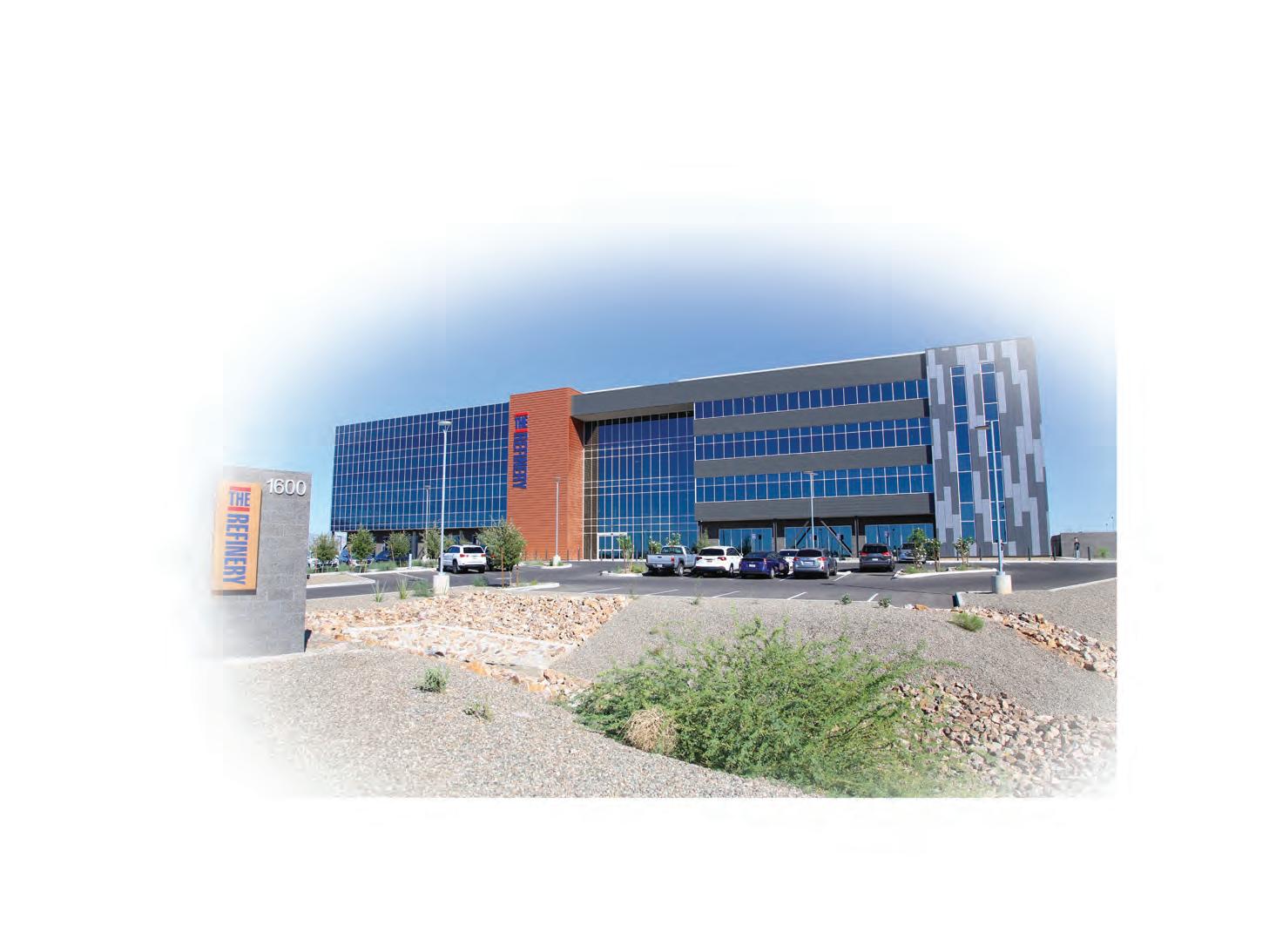
“We strongly feel the more that we grow this region, the more small com panies, medium companies and large companies that we have, the more in vestment we’ll see coming in,” Hocks tad said. “There will be more reasons for companies to stay here, and perhaps more importantly, more reasons for graduates to stay.
“The old adage is, ‘Go to the coast to find the money.’ They won’t have to do that because it’s going to be here. We’re starting to see that more. We have at least a half dozen venture funds in Ari zona now.”
One of those is UAVenture Capital, a fund started by local businessmen Fletcher McCusker and longtime busi ness partner Michael Deitch specifically to fund startups associated with the uni versity and usually launched through TLA. The idea to establish the fund was pressed by Robbins when he took the president’s job in 2017. McCusker had just engineered a $130 million sale of a company, SinfoníaRx, that was borne from a University of Arizona innovation.
Robbins “kind of nonchalantly asked me, ‘Can you do it again?’ I go, ‘Yeah.’ He says, ‘No, can you do it again and again and again.’ He said we need a fund, some risk capital to help these startup companies get off campus,” Mc Cusker recalled.
UAVenture Capital has invested $30 million into 11 companies that have
“I’m absolutely convinced we will develop more and more startups here in the region, some of which will become unicorn powerhouse companies.”
Betsy Cantwell Senior VP, Research, Innovation & Impact University of Arizona
80 BizTucson < < < Fall 2022 www.BizTucson.com
BizINNOVATION
emanated from the university, McCusk er said.
Cantwell sees all of this as the start of the innovation ecosystem.
She spent a portion of her educa tional and professional life in northern California, where she witnessed the de velopment of Silicon Valley as a poster child for an innovation ecosystem. She holds a doctorate in mechanical engi neering from the University of Califor nia, Berkeley. She worked in a technol ogy firm in the area and she also studied how Silicon Valley developed.
“When it started it was nothing,” Cantwell said. “Stanford was nearby, but that area did not even have silicon until Fairchild Semiconductor started there. There was a NASA base and a university.”
For the Tucson region to continue to establish itself as an ecosystem, Cantwell said, organizations and inter ests from all sectors, public and private, must contribute. The work done at TLA demonstrates that all things are possible.

“First, you’ve got to have the ideas. Then you’ve got to have the support
on page 82 >>>
from page 78
Codelucida Category: Computers/Software
Year Licensed: 2014 Shiva Planjery, CEO Inventors: Shiva Planjery, Bane Vacic, David Declercq


Codelucida empowers the future of data storage with enhanced speed, reliability, and lower power usage. Codelucida develops software that enables flash-memory-based devices to have higher capacities, higher reliability, and faster speeds using less power at lower costs. These ulti mately improve the efficiency and reliability of data centers, servers, and mission-critical storage that incorporate flash memories.
Participating Unit: College of Engineering codelucida.com
eSight Category: Optics/Health
Year Licensed: 2019 Brian Beardsley, CEO Inventors: Hong Hua, Jason Kuhn
To help the legally blind and those with low vision to function in daily life, Hua and Kuhn invented a wedge-shaped prism eyepiece design that provides both high resolution and a large exit pupil. The technology, which offers an image quality that has not been previously achieved, was licensed to eSight Corporation for its eSight 3 product.
Participating Unit: James C. Wyant College of Optical Sciences esighteyewear.com
on page 82

continued
>>> Fall 2022 > > > BizTucson 81www.BizTucson.com
continued
continued
IMAGE:

continued from page 81
FreeFall Aerospace Category: Aerospace Year Licensed: 2018 Doug Stetson, CoFounder, President & CEO Inventors: Chris Walker, Ira Smith
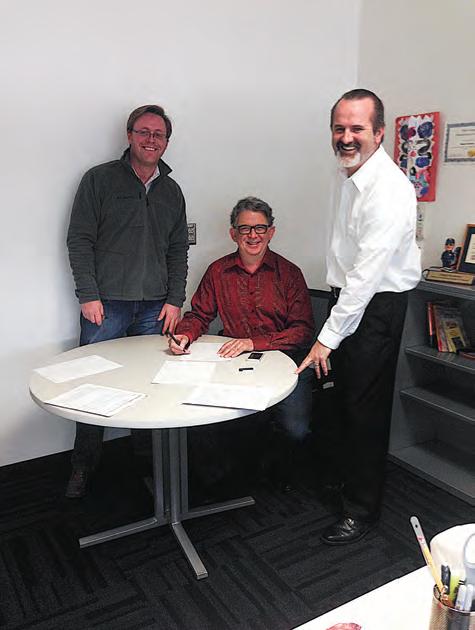

FreeFall’s revolutionary intelligent antenna system will enable the 5G Era. FreeFall’s unique 3-dimensional phased array antenna can provide high data rate communication at virtually any frequency at a fraction of the size and cost of any existing solution.
Participating Unit: College of Science
www.freefallmovingdata.com
Illustrative Mathematics
Category: Education Year Licensed: 2014 William McCallum, CEO
Inventors: William McCallum, Cody Patterson, Ellen Whitesides
Illustrative Mathematics is a not-for-profit company that provides com mon-core compatible lesson plans for K-12 math courses. With carefully crafted lesson plans and tasks, math concepts are taught intuitively. Additional supporting materials are provided online for teachers and industry professionals.
Participating Unit: College of Science
illustrativemathematics.org
continued from page 81
system that Doug’s unit (TLA) provides to perfect patents, create the IP,” she said. “You’ve got to have an ecosystem within the university that allows them to get started. You’ve got to bring funders to the table early. They’ve got be able to find rea sonably inexpensive labor. They’ve got to have places to go. They’ve got to have sup port services for startup companies. And they’ve got to have the right regulatory and legal environment.”
Some of those pieces are already work ing within UArizona.
TLA has a strong partnership with the university’s Tech Parks Arizona, even moving into the new building known as The Refinery at the Tech Parks at the Bridges where both units can work in close proximity. Tech Parks provides space and facilities for startups to get their businesses going in an environment where they can still be close to the university where many of the technologies are developed.
Tech Parks has 83 startup companies operating through its University of Arizo na Center for Innovation, the university’s affiliated startup incubator.
“It’s really key that we’re in lockstep with Tech Launch Arizona and the entire ecosystem,” said Carol Stewart, VP of Tech Parks Arizona. “I think people are figuring it out. They’re watching us and they’re like, ‘There is something pretty grand going on.’ ”
Over the long haul, Hockstad said, the type of ecosystem developing with organi zations like TLA and Tech Parks and with full support of one of the region’s largest entities and employers, the university can feed on itself by keeping students and re searchers within the region as a founda tion for the economy, even if not all the newly formed companies succeed.
“One of the things that I believe is that if we can create an ecosystem here where graduates can go right to a company or can feel comfortable going into a startup, that’s to everyone’s benefit because even if that startup fails, there’s another startup company or medium-sized or large com pany that they can go to. We get to retain a lot of our incredibly intelligent students,” Hockstad said, “and then we create an ecosystem that kind of feeds on itself as companies launch and/or fail and/or succeed.”
continued on page 87 >>> 82 BizTucson < < < Fall 2022 www.BizTucson.com
Biz
BizINNOVATION
COURTESY FREEFALL AEROSPACE


Fall 2022 > > > BizTucson 83www.BizTucson.com






Neuro-ID
Category: Software/Cybersecurity
Year Licensed: 2015
Jack Alton, CEO
Inventors: Joseph Valacich, Jeffrey Jenkins
In a face-to-face interaction, you evaluate how a person answers a question, not just what they say. Their tone of voice and their body language provide you with additional signals about the quality of the response and their state of mind. Neu ro-ID’s technology enhances online forms by revealing how questions are answered, not just what the answer is. In other words, the company enables its customers to read the digital body language of those interacting with their online forms.
Participating Unit: Eller College of Management neuro-id.com
LUM.AI
Category: Computer Science
Year Licensed: 2017
Kevin McLaughlin, CEO
Inventors: Gustave Von Hahn-Powell, Mihai Surdeanu, Marco Valenzuela
LUM.AI focuses on mitigating the innovation slowdown caused by information overload. The company applies natural language processing technology to augment R&D investments by distilling libraries of unstructured text and revealing mechanisms that matter.
Participating Unit: College of Science lum.ai
NeuTherapeutics
Category: Health/Medical Year Licensed: 2021
Robert Diaz Brinton, Founder and President
Inventors: Roberta Diaz Brinton, Kathleen Rodgers, Yu Jin Kim, Heidi Mansour
NeuTherapeutics is developing a new therapy for Alzheimer’s disease designed to restore cognitive function in early-stage patients. The therapy is now proceeding through a Phase 2b clinical trial. The team found that the neurosteroid allo pregnanolone, or allo, used to treat women with postpartum depression, promotes connectivity between neural networks required for cognitive function by generating new neurons and synapses in patients with the early stages of the disease.
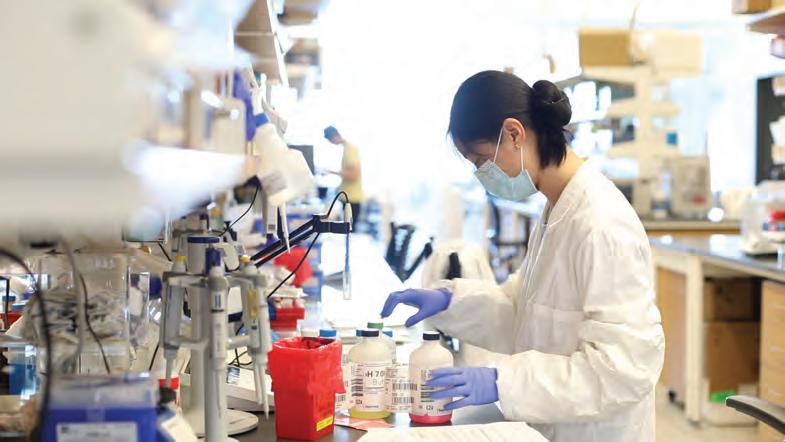



Participating Units: College of Medicine − Tucson, Col lege of Pharmacy, UA Center for Innovation in Brain Science, BIO5 Institute www.neutherapeutics.com

Lunewave
Category: Optics/Engineering
Year Licensed: 2017
John Xin, Co-Founder and CEO
Inventors: Hao Xin, Shufang Su, Min Liang, Siyang Cao

Lunewave develops cutting-edge antenna and sensor technology for wireless communications and autono mous vehicle applications. The company has developed t wo products, including an automotive radar sensing system and a high-speed antenna originally invented at the University of Arizona.
Participating Unit: College of Engineering www.lunewave.com

Fall 2022 > > > BizTucson 87www.BizTucson.com BizINNOVATION
continued from page 82 continued on page 89 >>>


Regulonix
Category: Health/Medical
Year Licensed: 2018
Rajesh Khanna, Chief Scientific Officer
Inventors: Rajesh Khanna, May Khanna, Vijay Gokhale, Reena Chawla, Erik Dustrude, Todd Vanderah
Regulonix is developing a non-opioid-based compound for chronic pain reduction. The team observed a synergistic effect when the compound was combined with morphine or gabapentin, a promising sign that the compound could also be used in a dose-reduction strategy for painkillers that have negative side effects, including opioids, while maintaining high levels of pain relief.


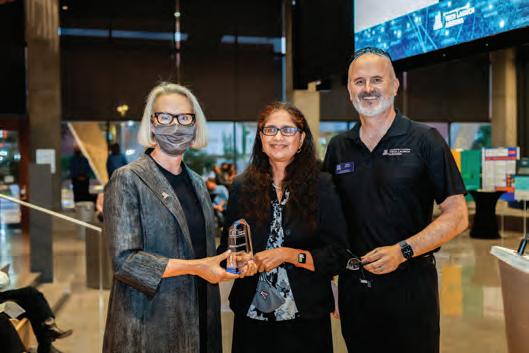


Participating Units: College of Pharmacy, College of Medicine − Tucson, BIO5 Institute, UArizona Health Sciences, UArizona Cancer Center www.regulonix.com
Phytocentric Solutions
Category: Agriculture/Life Sciences
Year Licensed: 2021
Bibiana Law, CEO
Inventors: Sadhana Ravishankar, Govindaraj Dev Kumar, Lubin Zhu, Bibiana Law
PhytoCentric Solutions has developed proprietary natu ral antimicrobial products for consumer applications. The star tup also provides testing services to the food industry.
Participating Units: College of Agriculture & Life Sciences, BIO5 Institute
SaiOx
Category: Health/Medical/Devices
Year Licensed: 2020
Manny Teran, CEO
Inventors: Sairam Parthasarathy, Marvin Slepian

SaiOx was founded to bring the benefits of heliox – a mixture of helium and oxygen – to those experiencing difficulty breathing. Heliox is less dense than air, thereby decreasing airflow resistance and allowing patients to breathe easier. This new respiratory assist device is small and portable, making it ideal for use in any setting, from intensive care units to the home.
Participating Units: College of Medicine − Tucson, College of Engineering, BIO5 Institute saiox.webflow.io
Procyon Technologies
Category: Health/Medical
Year Licensed: 2019
Inventors: Klearchos Papas, Robert Johnson, Steven Neuenfeldt
Procyon provides an implantable chamber fabricated from biocompatible synthetic membranes designed to hold allogeneic cells and protect them from immune rejection. Such cell therapy devices are designed to im prove cellular viability and function through the delivery of oxygen. The same devices are suitable for holding sensors or acting as a subcutaneous drug delivery system.
Participating Units: College of Medicine − Tucson, BIO5 Institute procyon-technologies.com
on page 93 >>>

Fall 2022 > > > BizTucson 89 BizINNOVATION
continued
continued from page 87
Moving Tech to Market
Firms Illustrate TLA Commitment to Innovation
By Jay Gonzales
For 10 years, Tech Launch Arizona has paved the way for inventions de veloped at the University of Arizona to make their way into the commercial markets either by way of existing com panies who have licensed the technolo gies, or by way of startup companies founded to commercialize specific in ventions. TLA’s work has resulted in the formation of over 125 of those startups since 2012.

The following three companies are examples of the commitment TLA and the university have made to commer cialize technologies developed around campus
Reglagene
Reglagene is developing an effica cious, safe and orally administered brain cancer therapy. The therapy is designed to treat a wide variety of can cers, including glioblastoma, the dead liest brain cancer, and brain metastases resulting from breast and lung cancers – the two cancers most likely to metasta size into the brain, said Reglagene CEO Richard Austin.
“The innovation of new and better therapies for the treatment of brain tu mors has been slow,” Austin said. “Af ter the first diagnosis of a brain tumor, most patients live less than a year.”
TLA matched Austin, who has a Ph.D. in organic chemistry and an MBA in pharmaceutical management, with one of the technology’s inventors, Laurence Hurley, who holds a Ph.D. in medicinal chemistry. They and univer sity researcher Vijay Gokhale founded Reglagene in 2018 to continue develop
ment of brain cancer therapies original ly discovered in the R.K. Coit College of Pharmacy and the BIO5 Institute with TLA’s support. Hurley is now the company’s CSO and Gokhale is VP of discovery.
“TLA played a crucial role in Regla gene’s founding,” Austin said. “TLA continued to support the company as we became operational, including mentorship, business coaching, grant-
writing training, pitch training, and or ganizing pitch opportunities in front of investors.”
The company remains based in Tuc son, opening the door for opportunities to contribute to the overall economic development of the region.
“These businesses (launched by TLA) provide primary jobs that often are the reason many UArizona grads can stay in Tucson,” Austin said. “Due to the wealth of new technology coming out of UArizona, TLA is positioned to have an even greater impact in the future through even more company forma tions, especially as the talent base of experienced technology entrepreneurs grows in our region.”
Auxilium Technology Group
Arizona residents are likely familiar with the ever-present mine tailings – the massive piles of waste materials that are a byproduct of the mining industry, which historically has been one of the region’s largest economic drivers.
A solution developed at UArizona and trademarked as Entail is a highly efficient extraction process aimed at pulling out useful materials from what has otherwise been treated as waste to minimize the environmental impact of the tailings.
“Auxilium’s mission is to be the benchmark and ignite a sustainable tail ing repurposing industry on a global scale,” said one of the inventors, Moe Momayez, a professor and interim de partment head in the Mining and Geo logical Engineering Department in the

“TLA has been instrumental in identifying new inventions, assessing the commercial viability of new technologies and building a strong, engaged network of commercialization partners.”
Moe Momayez Interim Head UArizona Mining and Geological Engineering Department
BizINNOVATION 90 BizTucson < < < Fall 2022 www.BizTucson.com continued on page 93 >>>


from page 90
UArizona College of Engineering.
“Mining companies use our solutions to minimize the environmental impact of mine tailings while achieving net-ze ro emission and decarbonization goals,” Momayez said.
He added that TLA helped in the for mation of the company through men toring, access to technology and other programs.
“Auxilium is constantly working with TLA on not only exploring the com mercial opportunities of new technolo gies, but also leveraging TLA’s exten sive network to foster company growth plans,” Momayez said.
Auxilium was one of two companies selected by BHP, an Australian mining company that is one of the largest in the world, to develop solutions to maximize the value of waste while minimizing the environmental impact.
“The mining sector is a significant contributor to the economy of the state of Arizona with an estimated total eco nomic impact of more than $6.5 bil lion,” Momayez said. “TLA has been instrumental in identifying new inven tions, assessing the commercial viabil ity of new technologies and building a strong, engaged network of commer cialization partners.”
UAVenture Capital
With all the knowledge and innova tion on the UArizona campus fueling the development of life-changing tech nology, there emerged a basic need that UArizona President Robert C. Robbins identified when he arrived on campus in 2017 – investment capital.


Almost as soon as he arrived, Robbins challenged businessman Fletcher Mc Cusker to develop a source of venture capital funding for the technologies that Tech Launch Arizona was working to commercialize.
“He said we needed a fund, some risk capital to help these startup companies come off campus,” McCusker said.
His answer was to establish UAVen ture Capital specifically to support the companies and technologies moving to ward commercialization with assistance from Tech Launch Arizona.
TLA Associate VP Doug Hockstad
on page 94 >>>
continued from page 89
Science of Sport
Category: Education/Engineering
Year Licensed: 2014 Ricardo Valerdi, Chief Scientist, Founder Inventor: Ricardo Valerdi

Science of Sport is a not-for-profit company developing sports-baseSTEM curriculum for K-12 students and teachers. Through partnerships with professional sports teams, Science of Sport provides camps to en gage students as they learn how STEM subjects find real-world appli cations in sports, with a particular focus on disadvantaged and underser ved communities.
Participating Unit: College of Engineering sciencesport.org
SinfoníaRx Category: Health/Medical/Software

Year Licensed: 2014
Kevin Boesen, Founder Inventors: Kevin Boesen, Kevin Barber, Rose Martin, Nicole Scovis, Jason Red dick, James Kloster, Ann Kerschen, Martin Pelger, Matthew Smith, David Armena Amaya
SinfoníaRx technology is a medication therapy management software for Medicare, Medicaid, MMP, exchanges and commercially insured patients. Every time a patient fills a prescription, their medication pro file is reviewed for potential medication related problems. The company uses targeted outreach to address need areas including safety concerns, adherence to national consensus treatment guidelines, adherence to prescribed medication regimens, and cost savings opportunities. The company was acquired by Tabula Rasa Healthcare Inc. in 2017.
Participating Unit: College of Pharmacy sinfoniarx.com
Fall 2022 > > > BizTucson 93www.BizTucson.com
continued
continued
BizINNOVATION


94 BizTucson < < < Fall 2022 www.BizTucson.com Tech Launch Arizona By the Numbers Economic Impact Study February 2022 Fiscal Years 2017-2021 Projected 2022-2031 Jobs Supported (Measured in Job Years) 10,781 31,533 Labor Income $561 million $1.6 billion Economic Output $1.6 billion $4.7 billion Tax Revenue Generated $59 million $172 million Source: Tech Launch Arizona
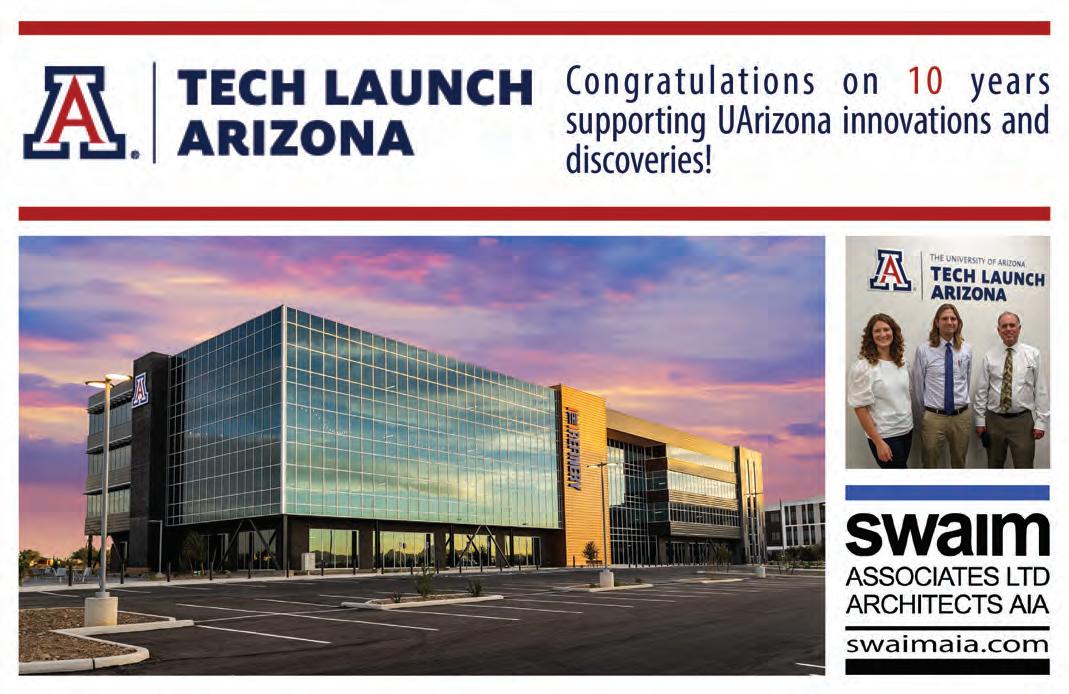

Fall 2022 > > > BizTucson 95www.BizTucson.com


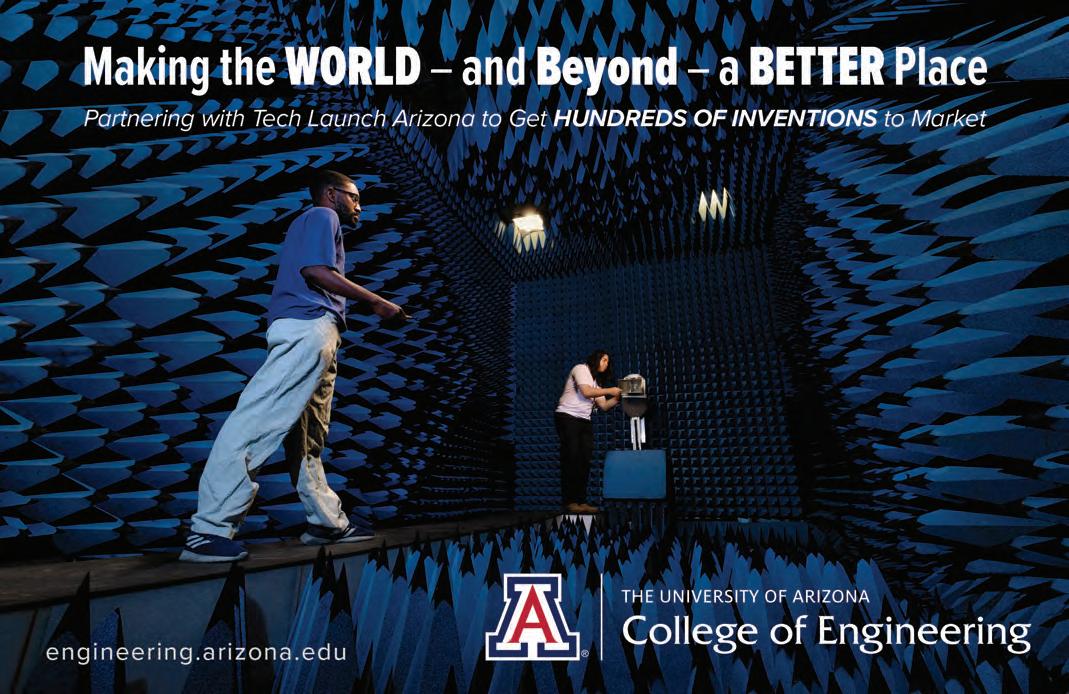
96 BizTucson < < < Fall 2022 www.BizTucson.com BizINNOVATION

